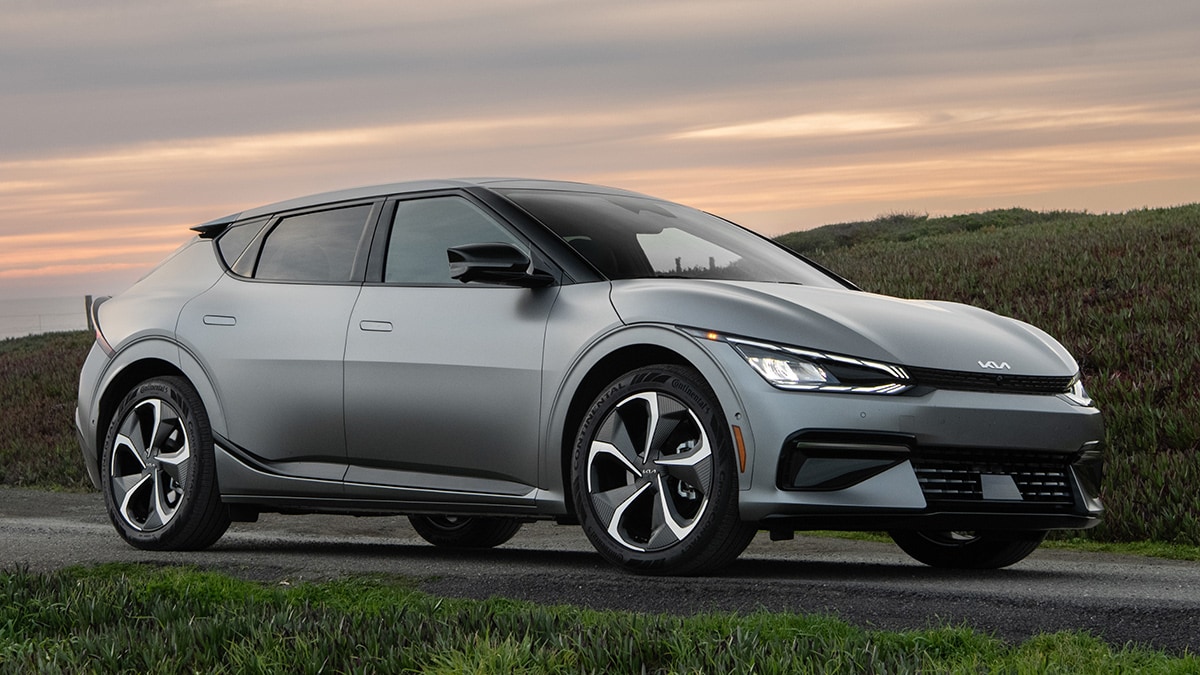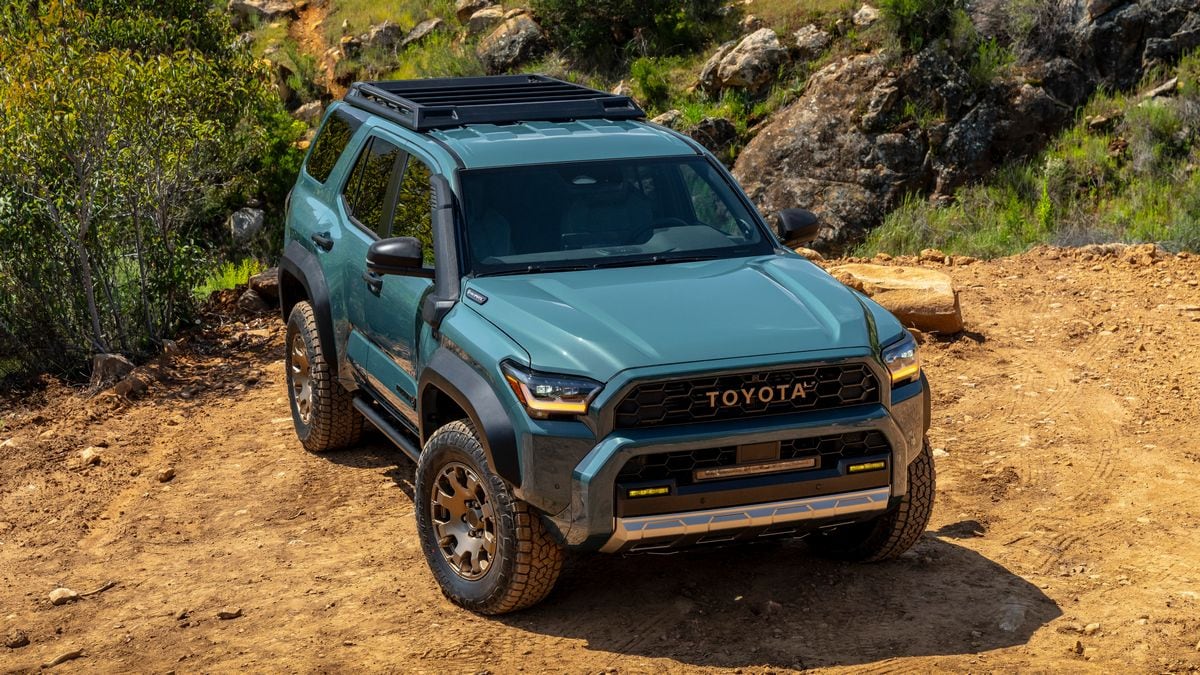Quick Facts About Leasing vs. Buying an Electric Vehicle
- Some automakers offer $7,500 in EV leasing incentives, even if the car doesn’t qualify for the tax credit when you buy.
- Car dealers ended 2023 with around 136,000 EVs awaiting sale. That makes it easier to find an electric vehicle with the features you want.
- Financing and leasing interest rates remain higher than normal.
As we consider the question of whether you should lease or buy an electric car, we will pretty much approach the lease vs. buy issue as we normally do. That is, the reasons for leasing or buying a pure electric vehicle (EV) are about the same as for a gas-powered car with an internal combustion engine (ICE). For our purposes here, we will assume you’ve done all the research and settled in your mind the overall question of driving an electric car versus an ICE vehicle. In other words, you are dead set on an EV.
Should you lease or buy in today’s automotive and EV-friendly climate? That’s a somewhat different matter. As you read through this story, we will summarize the current automotive market, provide some pros and cons for buying and leasing an electric car, and even discuss subscription services.
Today’s Automotive Environment
Today’s automotive marketplace is challenging for both dealers and consumers. Here are some influences conspiring to frustrate buyers and sellers.
New Car Inventories
According to Kelley Blue Book’s parent company Cox Automotive, new car prices are generally inching down as dealer inventories reach near-normal levels. However, it remains a mixed bag depending on the brand. What we often consider domestic brands, like Dodge, Ram, Ford, and GM, are seeing inventories well on the rise. However, the supplies of some Asian brands like Toyota, Honda, and Kia remain stubbornly tight.
Although electric vehicle sales set a 1-million-unit record in 2023 and account for more than 10% of total sales, automakers have built them faster than the current sales rate. Figures from Cox Automotive show dealerships’ EV inventory at the beginning of December was 114 days’ supply, well above the industry average of 71 days.
At the end of 2023, car dealers had roughly 136,000 new EVs awaiting sale, compared to about 92,000 sitting on lots six months before. That’s great news to a consumer set on an electric car, were it not for other factors, including higher interest rates.
High Interest Rates
The Federal Reserve spent much of 2023 raising interest rates, trying to slow inflation. In December, the Fed held rates steady for the third straight time. Consumers are now seeing interest rates on auto loans fall from peak rates in October, but the declines are modest so far, and rates remain historically high. Higher car loan and lease interest rates increase a vehicle’s cost to own. Higher interest rates have helped force some buyers with bad credit ratings out of the marketplace. Consequently, carmakers started focusing on and producing higher-priced models.
The average transaction price of a new electric car in November was $52,345, according to Cox Automotive data. Considering that Bankrate says the average interest rate on a 60-month auto loan is now about 7.7%, it’s bound to give you pause. Even with a 20% down payment ($10,500) on that average transaction price above on a 60-month loan at 7.7%, it will still work out to an $842 monthly payment before taxes. That monthly payment is out of reach for most Americans.
Inflation
Although the rise in inflation seems to be easing, it still means the budgets of most Americans remain under pressure. Consequently, the spike in car transaction prices, rise in interest rates, and less cash to spend make 2023 a tough time to acquire a car, whether or not it’s a new, used, or leased EV.
MORE: What Are the Benefits of Driving an Electric Car?
What’s the Difference Between Leasing and Buying?
One noteworthy difference between leasing and buying is monthly leasing payments are usually less than loan payments. This is because the car is yours when you pay off a loan. However, when you complete a lease, you turn in the keys with nothing to show for years of payments. In reality, leasing is just glorified renting.
Other differences include annual mileage caps, early termination penalties, and usually, leasing agents require much higher credit scores, among other negatives. You can check out everything you need to know about leasing in Kelley Blue Book’s Leasing Guide.
Pros of Buying an Electric Car
- Equity. Whether you pay cash or finance your electric car purchase, you will eventually have equity in the car. In the case of cash, that equity is immediate. If you finance, you begin to gain equity at some point along the way, and you will own the vehicle outright when the loan is paid in full.
- Customization. If you want to make your electric vehicle stand out or personalize it, you may customize it to your liking. You can change the wheels, install a leather interior, or apply a protective wrap to the exterior. But because a leased car is not yours and won’t be when the payment terms are fulfilled, it must be turned in as you received it.
- Freedom. At any time during the terms of your loan, you can sell or trade in your EV to acquire another vehicle. As long as you pay off any outstanding balance to the lender, the car is yours to do as you please.
- Refinance. If, at some point during the electric vehicle loan, you decide you can get a better interest rate or want to extend the payments for another year, you can refinance the loan. Again, if the refinancing isn’t through the same lender, any outstanding balance will need to be paid.
Cons of Buying an Electric Car
- Higher payments. Your monthly loan payment amount depends on several factors, like the length of the loan, the down payment amount, and the interest rate. However, a monthly loan payment will generally be more than a monthly lease payment. This difference could be hundreds of dollars.
- Bigger down payment. Because electric cars often cost more than ICE vehicles, buyers will need to come up with a bigger down payment. That down payment could be hefty if your credit comes with a few dings.
- Underwater. Although you can sell or trade your electric vehicle at any time, you always run the risk that you owe more than it’s worth. That’s also called being underwater or upside down. In other words, you must make up the difference between the amount you receive for the car and what you still owe. The dealer can roll that difference into the new financing when trading it in on another vehicle. However, that means you will be even more upside down in your next car.
Pros of Leasing an Electric Car
- Parade of new EVs. For drivers who always want the latest and greatest, leasing allows for replacing an electric car every two or three years, depending on the lease length. This is usually a painless process of turning in your current EV, signing another lease, and driving off in a new car.
- Little skin in the deal. Typically, a consumer with better-than-average credit can get into a lease with minimal upfront money. Leasing companies often only require a deposit, a fee or two, and the first month’s payment. Some special leasing deals offered by carmaker financing companies, like Ford Motor Credit and Nissan Motor Acceptance Company, will run leasing deals also requiring a small amount of cash down. However, generally, you can get into a lease with less upfront cash than a loan requires.
- In warranty. Leasing provides lasting warranty protection because most new EV leases are for two or three years. Every new vehicle factory warranty on the market is for a minimum of 36 months or 36,000 miles. In other words, the factory warranty will always cover a leased EV if you don’t exceed the annual mileage cap.
- No fuss. Unless you’ve mistreated your leased EV or exceeded the annual mileage cap, you can hand over the keys and walk away when the lease ends. Even if the EV is worth less than the lessor projected it would be at lease end, you won’t owe a penny more.
- Option to buy. You can buy the electric vehicle at the end of a lease rather than turn it in. The lease-end purchase price is contractually stated in the lease. Here’s the good news: Because the lessor projects the EV’s projected book value at the end of the lease, you may find buying the vehicle a bargain. Why? Because if the lessor projected wrong and pegged the value at the end of the lease lower than the future book value actually is, you get to buy it at that lower price.
Cons of Leasing an Electric Car
- Zero equity. The greatest negative of leasing an EV for the average consumer is that the lessee has nothing at the end of the lease. In other words, the lessee doesn’t have a vehicle and doesn’t have anything to put down toward acquiring another car.
- EV bondage. While offering a sense of freedom when handing over the keys and walking away at the end of the lease term, leasing bounds the lessee to the electric vehicle for the duration of the lease. Unlike financing through a loan, which allows the buyer to sell or trade in the EV at any time, a lease contract binds the lessee to the vehicle for the life of the lease. Sure, you can get out of a lease early. But it will usually involve hefty early termination penalties. Sometimes these penalties include paying the total of any remaining monthly payments.
- Wear and tear. Leasing is really extended renting. In other words, you are essentially borrowing the vehicle and paying for that privilege. The leasing agent expects you to return the car in the condition it was in when you borrowed it, minus normal wear and tear: a nick here and a small ding there. Anything a lessor deems beyond normal wear and tear will cost you, including interior and exterior damage. What is “normal” is subjective and up to the lessor. The lessor will charge you for any damage considered above its definition of normal.
- Mileage cap. Lease contracts include an annual mileage cap restricting the number of miles a lessee can drive a car each year. Exceeding that cap triggers a per-mile charge for each excess mile. The average cap is 12,000 miles per year or 36,000 miles over a 36-month lease. A typical penalty is about $0.25 per excess mile. Therefore, if you exceed that 36,000-mile cap by 4,000 miles, the lessor will assess an extra $1,000 at the lease termination.
PRO TIP: Whether you buy or lease an EV, there’s a chance it could qualify for federal and state tax credits. However, navigating the amount of the credit and which vehicles qualify can be confusing. It’s even more difficult if you lease your electric car. The number of electric car models that still qualify for tax credits is decreasing, but if you and your EV meet all the qualifications, the savings can be as much as $7,500 off the price. Moreover, some states and localities offer additional incentives. Check out the latest updates in Kelley Blue Book’s How Do Electric Car Tax Credits Work in 2024 and Electric Car Rebates and Incentives: What To Know by State.
MORE: Do Electric Cars Have Transmissions?
What About an Electric Car Subscription?
Beyond buying and leasing, you can drive a new (or near-new) electric car through a subscription service. Think of it as a cross between leasing and renting or a hybrid of sorts. Like renting and leasing, you owe and own nothing when the subscription term is complete. It also doesn’t require much in the way of upfront cash. However, unlike renting and leasing, your monthly subscription payment includes insurance and scheduled maintenance.
Although factory-sponsored subscription services have lost some steam in the last few years, Volvo and Porsche still offer subscriptions with all the bells and whistles. Hyundai recently launched its Hyundai Evolve+EV subscription service that features the Ioniq 5 and the Kona Electric models.
There are a few third-party subscription services, as well. Steer EV offers a comprehensive subscription service offering several electric vehicle models from assorted carmakers. There are other non-affiliated subscription programs, as well.
Pros of EV Subscriptions
- Insurance. Your monthly subscription payment includes auto insurance.
- Zero down. Other than a one-time activation fee required by some subscription services, no upfront cash is needed.
- No negotiating. You pay the same monthly fixed fee, no matter the EV or the circumstances.
- No financing entanglements. Although you must meet certain credit requirements, any financing costs and fees are rolled into the monthly subscription payment.
- Fingertip access. With few exceptions, you can complete the entire subscription process from the comfort of your home using the appropriate app. You can subscribe, be approved, pick an EV, set up monthly payments, and specify a delivery date and location on your smartphone.
- Versatility. You can begin and terminate a subscription almost at will. Some programs establish a fixed length for each vehicle, which can be one month, three months, and so forth. These short-term events allow for flexibility to meet your needs. At the end of the designated term, you return the electric vehicle, trade it in for another, or pause the subscription.
- Other perks. The added benefits include free delivery, pickup, and 24-hour roadside assistance.
Cons of EV Subscriptions
- Limited selection. Although some subscription services like Porsche Drive open its entire lineup to subscribers, most don’t. Even third-party services not restricted to a single carmaker only offer specific models. As difficult as many electric models are to buy, they are even more scarce among subscription services.
- Geography. Many subscription programs only serve specific cities or regions. The service is unavailable if you don’t reside within the appropriate locations.
- Excess wear. With a subscription EV, you will still be responsible for any excess wear and tear.
- Lack of equity. No matter your monthly subscription payment, when the subscription period ends, you have nothing to show for those payments.
- Monthly payment. Despite the convenience of rolling most of the ownership costs into the monthly subscription payment, it will probably be higher than leasing.
- Mileage limit. With a subscription comes a limit on the mileage you can put on a car per month. Some subscriptions also have other restrictions, such as crating pets and not driving into Canada or Mexico.
- Charging. Efficiently charging an electric vehicle at your residence requires a Level 2 charging station. Otherwise, you need to charge at a public station in your area. This can be inconvenient and time-consuming.
What About Leasing or Buying a Used Electric Vehicle?
You may consider leasing or buying a used EV, depending on the mileage and age. Carmakers warranty EV batteries for at least eight years or 100,000 miles. Consequently, if there is still time and miles left on the battery warranty, a used EV may be a good deal.
When buying a used EV, you might consider if you qualify for federal tax incentives for cars under $25,000. If eligible, the credit is $4,000. Also, the used car must be at least two model years old and purchased at a dealership. The vehicle also only qualifies once in its lifetime. Used vehicle buyers can only qualify for one credit every three years.
MORE: Are Electric Cars Better for the Environment?
Lease or Buy an Electric Car?
We recommend buying over leasing for most car shoppers in a normal market. But this isn’t a normal market. Furthermore, we’re discussing EVs. On average, EVs carry a higher price tag than comparable ICE vehicles. Consequently, leasing’s historically lower monthly payments can help those in the market right now. Furthermore, electric vehicle owners tend to be more sensitive to the newest technology. Leasing allows drivers to regularly move on to the latest tech in the newest electric vehicles with very little fuss.
Advantage in 2024: Leasing.
PRO TIP: Having purchased a new car in 2023, I can tell you that unless you order and are willing to wait several months to take delivery, odds are, you will have to compromise. The ICE SUV that I really wanted was neither expensive nor unique. However, it simply wasn’t among inventories in Greenville, South Carolina, or within 50 miles. Considering the very stingy supply and selection of EVs at dealerships at the time, you will be in a small minority if you score precisely what you want from EVs already on the dealer lot. Be prepared to compromise whether you lease or buy.





